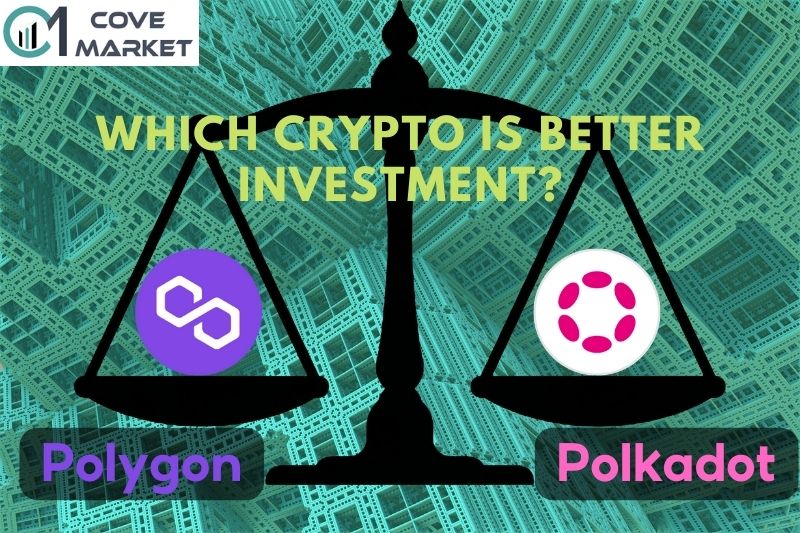Polkadot and Polygon are two networks similar in more ways than just their names. They both want to make blockchain networks bigger. As the number of blockchains rapidly expands, they are becoming increasingly fragmented. Polygon vs Polkadot are two blockchain projects that are working towards interoperability. In other words, they strive to be “the Internet of Blockchain,” making blockchains more connected. Let’s explore the difference between these two seemingly similar coins!
Overview
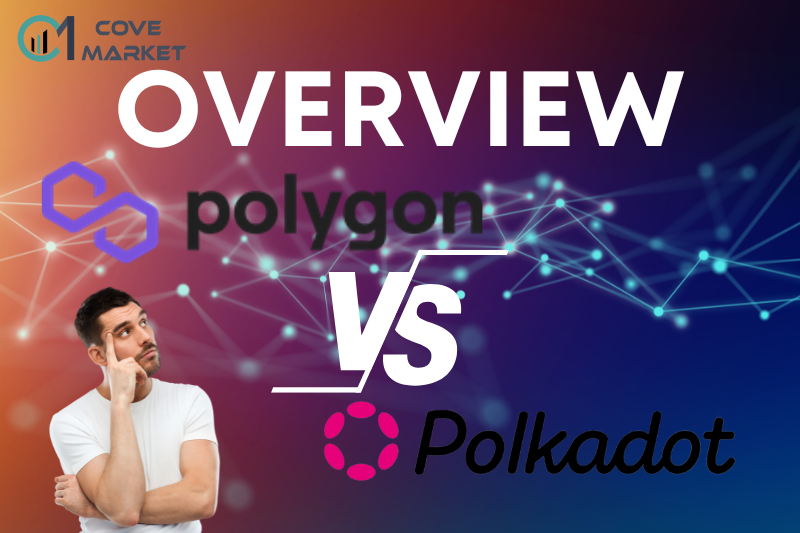
What Is a Crypto Ecosystem?
A crypto ecosystem is a collection of digital assets and platforms that work together to create a complete system. It typically includes a cryptocurrency, a blockchain, and a decentralized application (DApp).
What’s Unique About Polygon?
Polygon is a unique cryptocurrency because it uses a Proof-of-Stake (PoS) consensus algorithm instead of the more common Proof-of-Work (PoW) algorithm. PoS is more energy efficient and environmentally friendly than PoW. Polygon is also unique because it’s built on top of Ethereum, which means it has the potential to scale Ethereum’s network.
Read more: Comparison of Two Blockchain Consensus Algorithms: PoW Vs PoS: Which Is Better For You 2023
What’s Unique About Polkadot?
The Polkadot network has a unique architecture that allows it to connect multiple blockchains together and handle transactions quickly and securely.
This makes it possible for different blockchains to communicate with each other and share data, which could potentially revolutionize the way the internet works.
Advantages vs. Disadvantages
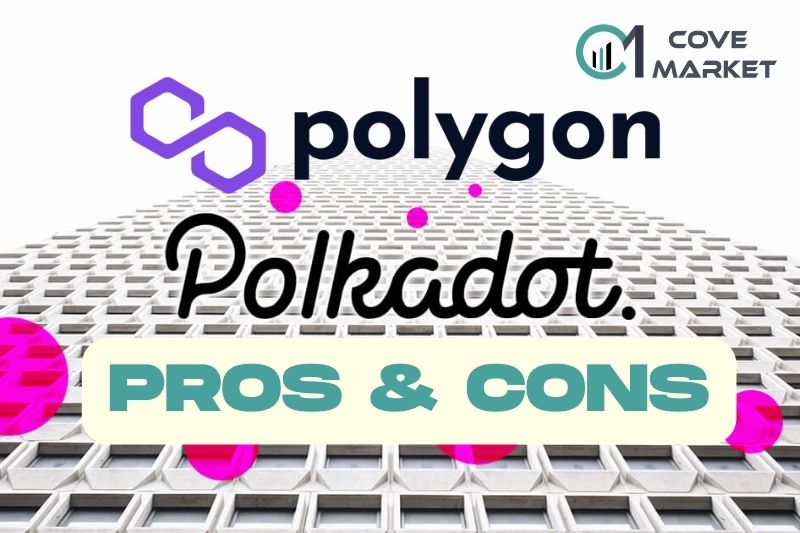
MATIC | DOT | |
| Pros |
|
|
| Cons |
|
|
What Do They Have in Common?
Polkadot and Polygon are two projects working together to build an interoperable blockchain network. They use PoS consensus to address and resolve the current issues with leading cryptocurrencies. This will add value to the blockchain space as a whole.
Polygon Vs Polkadot: What Are The Differences Between 2 Ecosystems?
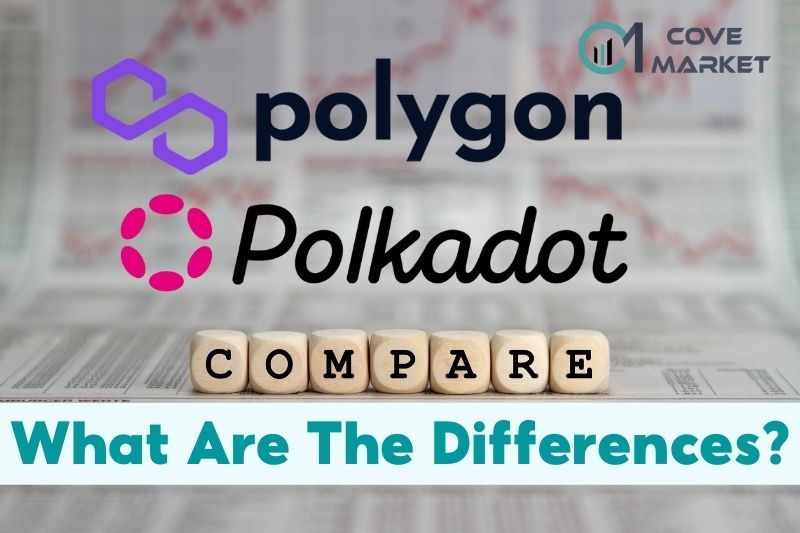
Mechanism
- Polygon uses a unique proof-of-stake consensus mechanism that allows for instant consensus with every block. This eliminates the need to process numerous blocks to achieve consensus, as traditional proof-of-stake methods require. In exchange for agreeing not to trade or sell their MATIC, network participants are given the right to validate Polygon transactions. Successful validators are rewarded with MATIC.
- Polkadot’s proof-of-stake consensus mechanism (as opposed to the proof-of-work system Bitcoin uses) is designed to secure the network, verify transactions, and create and distribute new DOT. DOT holders can interact with the staking system in several ways, depending on how much time, technical knowledge, and money they want to devote.
Programming language
- To create smart contracts on Polygon, it uses Solidity – the same programming language used on Ethereum. Besides, Polygon SKD is a flexible and extensible framework for building ETH-compatible networks, written in Golang —an open-source programming language.
- On the other hand, developers for Polkadot can write code in both Go and C++. Polkadot’s mainnet has been running since May 2020, and it can be programmed in many different languages, from Rust to JavaScript. Currently, the best implementation is made with Rust and the Substrate framework.
Technology

MATIC
Polygon uses several different technologies to get expanded its vision, including:
- POS Chain: Polygon’s main chain is an Ethereum sidechain known as the Matic POS Chain, which adds an extra layer of security to blockchains launched on Polygon by using a proof-of-stake (POS) system.
- Plasma Chains: Polygon employs a scaling technology called Plasma to move assets between the root chain and child chains via Plasma bridges.
- ZK-rollups: An alternative scaling solution combines many off-chain transfers into a single transaction using zero-knowledge proofs for the final public record on Ethereum’s main chain.
- Optimistic rollups: A solution that utilizes Ethereum to facilitate near-instant transactions through the use of “fraud proofs.”
Polkadot
Polkadot’s relay chain is built with Substrate, a blockchain-building framework that draws on Parity Technologies’ experience building Ethereum, Bitcoin, and enterprise blockchains.
Polkadot’s state machine is compiled to WebAssembly (Wasm), a virtual environment that is extremely fast and efficient. Wasm is developed by some of the world’s biggest companies, including Google, Apple, Microsoft, and Mozilla. These companies have created a large, supportive ecosystem for the Wasm standard.
Polkadot’s networking is powered by libp2p, a flexible, cross-platform network framework for peer-to-peer applications. libp2p is positioned to be the standard for future decentralized applications, and handles peer discovery and communication in the Polkadot ecosystem.
Decentralization
- Polygon is a decentralized Ethereum scaling platform that enables developers to build scalable user-friendly dApps while still maintaining security.
- Polkadot will make it possible for users to run a completely decentralized web. Polkadot is made to connect private and consortium chains, public and permissionless networks, oracles, and future technologies that haven’t been made yet.
Downtimes
Polygon
On July 1, 2023, the Polygon network announced that the Ankr RPC gateway had been subject to a DNS Hijack attack. DNS Hijack takes control of the domain name resolution system (DNS) and redirects the website address that the user visits. The attack is said to have compromised control over several services on the Polygon network. However, one of the latest update announcements confirmed that the Polygon PoS network is not affected.
Polkadot
The decentralized hub of the Polkadot network, Acala, suffered a major security breach, prompting it to pass an emergency vote to halt operations.
The hack was due to a flaw in the iBTC/AUSD pool, which allowed the attacker to issue an extra $1.2 billion in Acala (AUSD). At press time, the attacker’s wallet had 785,938 AUSD tokens.
Transaction cost (Gas fees)

The Polygon Matic network’s gas fee is usually between $0.0005 and $0.2 and has been going up. Crypto analysts say the Polygon Matic gas fee could return to $0.1 in the coming months.
Polkadot handles transactions in parallel and can grow indefinitely, which is hard to match if the projections come true. Polkadot, on the other hand, lets users send transactions for free, with no transaction fees. In the Polkadot ecosystem, this is called the zero-cost blockchain transaction fee.
Transaction speed
The Polkadot network can process more than 1,000 transactions per second, compared to about 7 for Bitcoin and 30 for Ethereum. This is because Polkadot is designed to connect different blockchains together.
On the other hand, Polygon blockchain can handle up to 65,000 transactions per second, and it takes less than two seconds to confirm a block.
Network size
MATIC
Polygon is the first platform for scaling and building infrastructure on Ethereum that is well-organized and easy to use. Its central part is Polygon SDK, a modular, flexible framework that can be used to make many different kinds of apps.
There are currently 100 validators securing Polygon’s chain with 100 nodes per validator.
DOT
The Polkadot network is composed of a relay chain and a set of parachains. The relay chain is the backbone of the network, responsible for maintaining the global state, while the parachains are specialized chains that can be used to execute specific tasks.
The size of the Polkadot network will depend on the number of parachains that are connected to it. As of right now, there are 24 parachains active on the network. However, the network is designed to support up to 100 parachains. Polkadot has a total of 16 validators with 230 nodes each validator.
Scalability
- Polygon is a Layer-2 scaling solution that helps bring mass adoption to the Ethereum platform. It provides tools to create scalable decentralized applications (dApps) that prioritize performance, user experience (UX), and security.
- Polkadot was made with the idea that it could work with other systems and as an external chain bridge. It uses the parachain model to complete transactions quickly, securely, and at a lower cost.
Market cap
| Polygon (MATIC) | Polkadot (DOT) | |
| Market Cap (USD) Volume Rank Circulating Supply Total supply | 6,719,586,188 $419,855,925 12 8.73B MATIC 10,000,000,000 | 7,999,326,000 $346,470,633 10 1.11B DOT 1,229,404,022 |
DeFi ecosystem
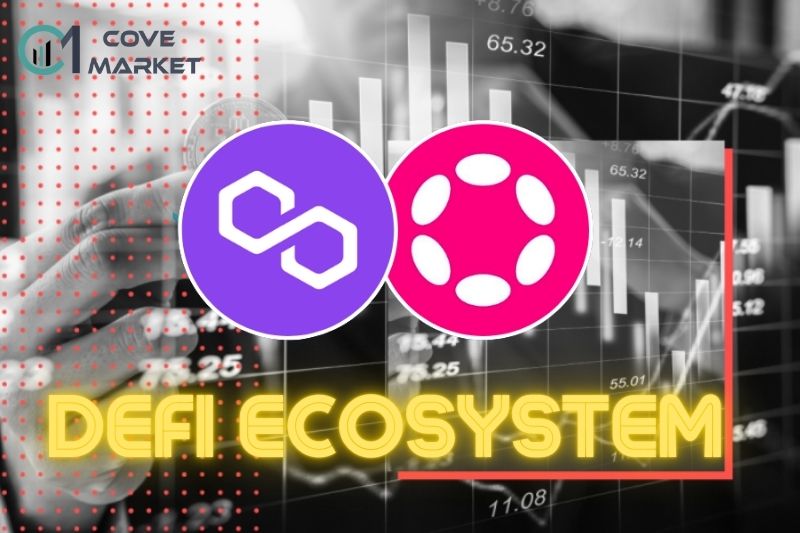
Polygon
Polygon has entered the “accumulation” phase, as real developers start building applications on the platform. The important pieces of DeFi on Polygon also appear and are initially connected with each other.
- Dex: AMM is the main Dex model used on Polygon Network. There are a lot of Dexs that support Polygon Network right now, but these five are the most well-known: Quickswap, DFYN, Sushiswap, Curve, Ox.
- Lending & Borrowing: The most prominent is Aave. Some less popular Lending Protocols than Aave include: beefy Finance, Adamant Finance, Autofarm Finance,…
- Yield aggregator, Yield Farming & Yield optimizer Platform: With the strong growth of Dex and Lending & Borrowing, they have made a vast source of yield for yield mining products (Yield aggregator, Yield Farming & Yield optimizer Platform). Some great Yield optimizer projects on Polygon are beefy Finance, Adamant Finance, Autofarm Finance,…
- Stablecoin: DAI, USDT, and USDC are the three most popular stablecoins used on Polygon.
Read more: Polygon Vs Ethereum: MATIC Vs ETH. Which Crypto Is Better In 2023
Polkadot
There are several DeFi teams in the Polkadot ecosystem:
- Acala – Polkadot’s DeFi hub and decentralized stablecoin, aUSD, allows users to send and receive USD across any blockchain connected to Polkadot.
- Stafi – Staking tokens can be used to immediately trade for and exchange an alternative token (rToken) without waiting for the unbonding period to complete.
- Bifrost – With the parachain, users can deposit their staking tokens to mint vTokens and get staking liquidity.
- Equilibrium – a cross-chain money market that enables pooled lending, synthetic asset generation and trading.
- Centrifuge – With DeFi, businesses can secure financing against their accounts receivable and other future cash flows, without needing to trust a middleman. Additionally, the Centrifuge chain provides a gateway for real world assets into DeFi.
- Zenlink – a cross-chain DEX network.
- HydraDX – Crypto assets can be easily and quickly converted into cash with no friction.
- Laminar – a platform that powers synthetic assets, margin trading and money markets built by Acala, decentralized finance.
- Mangata – a DEX that protects against frontrunning with low, fixed fees and no network fees.
- PolkaSwap – Soramitsu team’s automated market maker (AMM)/non-custodial exchange is a game-changer.
- SushiSwap – a community run AMM.
- Clover – a DeFi platform for the Polkadot ecosystem that is run by Bithumb and uses DeFi.
Read more: TOP Polkadot Projects To Know In 2023: DeFi, P2P, NFTs, Metaverse
NFTs

Polygon
Polygon Studios has been a great supporter of the NFT gaming sector on Polygon, helping it to develop quite well. Some of the most popular games on the platform include ZED RUN, Loser Chick, and Decentraland, which all have a stable number of monthly users. Of course, most of these projects are still in the early stages of development, without many outstanding updates.
Polkadot
Bit.Country’s decentralized platform on Polkadot allows users to build their own Metaverse with powerful built-in features like Token Economy, Marketplace, NFT management, Staking and Governance to support their own community building.
The NFT and Gaming segment on Polkadot hasn’t had many outstanding projects, but some notable ones include CryptoSpells, PolkaFantasy, Lamdamoon Metaverse, myNFT, CheersLand, and more.
At a Glance
| Polygon | Polkadot | |
| Launch | Oct. 2017 | Concept in 2016, Launch in 2020. |
| Consensus Mechanism | Polygon makes use of the Proof of Stake as its consensus mechanism. | Polkadot makes use of the hybrid consensus model for its blockchain. |
| Transaction Per Second | Speculated to be 65,000 TPS. | So far recorded 1000 TPS. |
| Programming Language | Solidity | Substrate (Rust framework) |
| Security | zkRoll Up Security | Shared Pool Security |
| Smart Contracts | Yes | Yes |
| Staking | Yes. 5% rewards for stake. | Yes. 7% to 12% for its stake. |
| Use Case | DeFi, Interoperability between Chains, Bridge and Ethereum Layer 2 solution use cases. | Multi-chain connectivity, smart contracts, interoperability, Slot based secure chain model & respective policy based use cases |
Future Projections
On Polygon
- Polygon is trying to get projects in the NFT and DeFi markets to switch from Ethereum or build directly on Polygon Network (3 – 10 projects weekly).
- Polygon is also finishing up the Framework, which will help people build other solutions that can be expanded (Stand-alone Networks, Secured Chains, Zk Rollups, and Optimistic), which are expected to be released at the end of Q3 and Q4, respectively.
- As the Polygon Network’s base is built, more and more chains will be built on top of it. Eventually, the goal of an “Internet of Blockchain” will be reached.
Read more: Polygon Vs Solana: Which Crypto Is Better In 2023
On Polkadot
Polkadot’s development project in 2023: Upgrades to XCMP (Cross-Chain Message Passing) and the launch of parathreads will make it possible for blockchain applications to communicate with each other directly, without the need for a third-party.
MATIC vs DOT: Which Is a Better Investment?
Both Polkadot and MATIC are promising altcoins with regular upgrades that are expected to soar high in the future. To answer this question, Cove Markets believe that investing a 50% share in each is ideal.
Where to buy MATIC and DOT?
Polygon and Polkadot can be bought on exchanges such as Uphold, Binance, and KuCoin.
Read more: KuCoin Vs Binance: Which Crypto Exchange Is Better For You in 2023 Full Comparision
FAQs
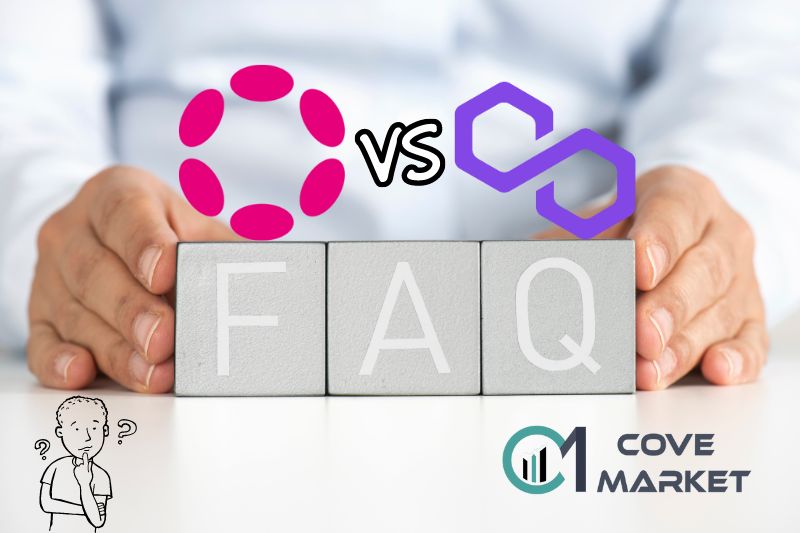
Which one should I choose?
It depends on your specific needs and preferences. However, in general, Polkadot may be a better choice if you are looking for a more scalable and flexible blockchain platform. In comparison, Polygon may be a better choice if you are looking for a more user-friendly platform with built-in security features.
Which one is the best ecosystem?
Some people may prefer the Polkadot ecosystem because it is more scalable and flexible, while others may prefer the Polygon ecosystem because it is more user-friendly and has a more active community. Ultimately, it is up to the individual to decide which ecosystem is best for them.
Is Polygon more secure than Polkadot?
There is no definitive answer to this question as both Polygon and Polkadot offer different benefits and drawbacks in terms of security. While Polygon may offer more comprehensive security features, Polkadot may be more secure in terms of its overall network design. Ultimately, it is up to the user to decide which platform offers the most security for their needs.
Which is more advanced?
Both projects are constantly evolving and improving. However, Polkadot may be considered more advanced due to its focus on interoperability and scalability. Additionally, Polkadot has been designed to accommodate a wide range of use cases, whereas Polygon is primarily focused on Ethereum.
Is Polygon or Polkadot more popular?
It depends on a number of factors, including personal preferences, investment goals, and overall market conditions. That said, both Polygon and Polkadot are popular projects in the cryptocurrency space and have strong communities of supporters.
Why are they so popular?
There are a few reasons for this:
- First, both projects are focused on building an ecosystem of decentralized applications (dApps). This is a major pain point for many blockchain projects, as most are only focused on one use case.
- Second, both projects have strong communities behind them. Polygon has the backing of some of the largest companies in the space, including Coinbase and Binance. Polkadot also has a large community of developers and users.
- Finally, both projects have a lot of potential. Polygon is working on scaling solutions that could make it the go-to platform for dApps. Polkadot is working on a cross-chain solution that could make it the go-to platform for interoperability.
Read more: Coinbase vs Binance: Which Crypto Exchange is Best?
Where can I learn more about them?
You can find more information about them through the website:
- The official website for Polkadot is https://polkadot.network/.
- The official website for Polygon is https://www.polygon.technology/.
- You also find a lot of information related to Polygon and Polkadot through our website: https://www.covemarkets.com/
Conclusion
In conclusion, it is clear that both Polkadot and Polygon have a lot to offer investors in 2023. However, which one is better ultimately depends on your own investment goals and risk tolerance. If you are looking for a more speculative investment with the potential for higher returns, then Polygon may be the better choice. However, if you are looking for a more stable investment with lower but more predictable returns, then Polkadot may be the better option.
Cove Markets strives to provide you with all the information you need to help you make an informed decision about whether to invest in Polygon or Polkadot. We hope your investment results will be favorable.
Disclaimer: The information provided in this article is not investment advice from Cove Markets. Cryptocurrency investment activities are yet to be recognized and protected by the laws in some countries. Cryptocurrencies always contain financial risks.
Polkadot Vs Solana: DOT Vs SOL. Which Crypto Is Better In 2023
Layer 1 Vs Layer 2 Vs Layer 3: Blockchain Scaling Solutions Need To Know 2023
BEP2 vs BEP20 vs ERC20: Which Is The Best Choice For You 2023?
TOP 10 Best Blockchain Companies To Know In 2023: Blockchain Technology Giants

